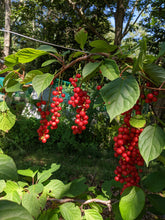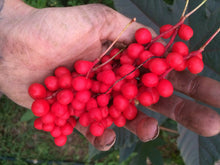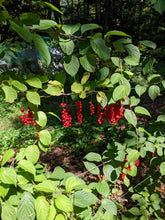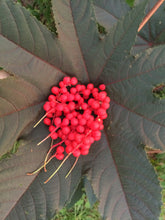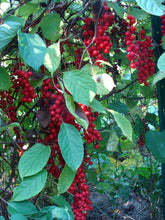Eastern Prince Schisandra
Regular price
$5.00
Sale
Schisandra chinensis
Origin: Northeast Asia
Improvement status: Cultivar
Seeds per packet: ~20
BOTANICAL SAMPLE - NOT GERMINATION TESTED
Life cycle: Perennial
Shisandra is a perennial woody vine native to temperate Asia's far East, including Russia, northern China, Japan and Korea. Also known as "Five Flavor Vine" or "Magnolia Vine," it is incredibly cold hardy (to Zones 3 or 4). The bright red berries with a unique flavor are used fresh or most often dried as both a flavoring and an herbal medicine. The name "Five Flavor Berry" comes from the complex nature of the berry's taste, combining sweet, sour, bitter, salty, and pungent flavors. In traditional Chinese medicine, schisandra ("wu wei zi") is used much like ginseng or reishi mushroom, as a general tonic for everyday use, but it is also used specifically for stomach and liver problems (and recent studies have demonstrated a likely ability to aid the liver and nervous system specifically). Modern herbalists consider it an "adaptogen," reducing physical and mental stress and increasing energy. Scientific studies are beginning to show that this is a powerful plant. Memorial Sloan Kettering Cancer Center has a webpage chronicling the various studies showing it may have great potential for people suffering from cancer or going through a liver transplant. This is a plant worthy of far more study than it has undergone thus far.
'Eastern Prince' is an uncommon self-fertile cultivar. Schisandra is typically a dioecious plant (meaning nearby males plants are necessary for female plants to set fruit). These seeds will not grow true to type, so seedlings from 'Eastern Prince' are mostly dioecious, but you may end up with some that are self-fertile too. Schisandra wants to climb, so it should be provided with a permanent arbor or trellis, or a fence or a wall or a row of sparsely-branched trees. It prefers an edge habitat, with some sunlight and some shade, but is adaptable, especially in northern areas. In places with hot summers, it will benefit from more protection from the sun. Berries should be harvested when fully ripe and can be used fresh or dried for future use. Seedcoats should be scarified (filed down) or nicked, as well as soaked, to aid germination. Cold strafitication may help too, as in nature the seeds fall into the ground in fall (usually after passing through an animal) and stay there until sprouting in the spring.
GROWING TIPS: Keep seeds cool and damp until March or later, then sow 1/4” deep. Germination can be slow, but is usually reliable with seeds that have not been dried. Starting in containers outdoors is the most reliable tactic in my experience.
Established plants produce well in full sun in northern climates, they prefer part shade in the south. Schisandra likes rich soil and heavy organic mulch. Trellising on horizontal wires encourages heavy fruiting and makes for an easy harvest. While the parent plant (Eastern Prince cultivar) is reliably self fertile, seedlings produce best with multiple seedlings in the same area.






